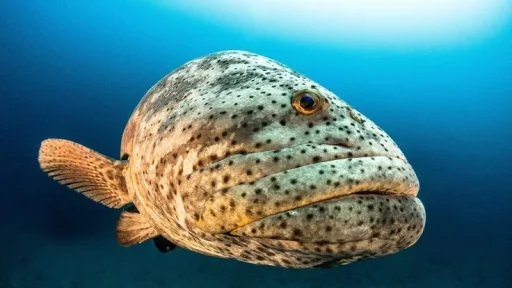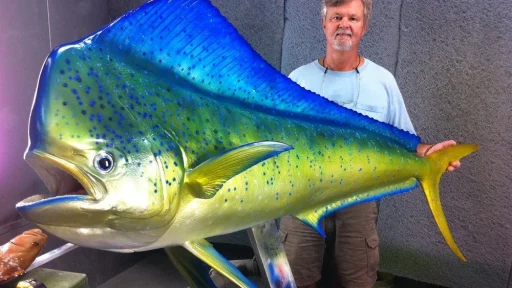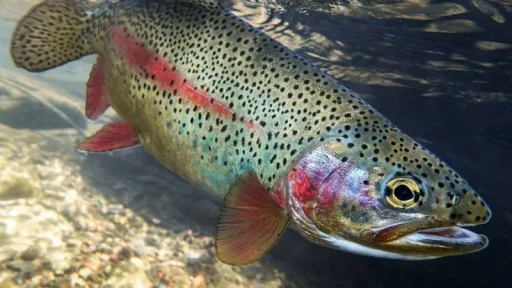The mutton snapper can weigh up to 30 pounds and grow 2-3 feet long. It’s a big deal in the reef fish world. Anglers love it for its looks, strong fight, and tasty meat. Knowing about the mutton snapper makes fishing more fun, whether you’re a pro or just starting.
Mutton snappers belong to the Lutjanidae family, like Red Snappers and Yellowtail Snappers. They’re huge, especially in the Florida Keys, where they often hit 20 pounds. Catching one is thrilling. They can live up to 40 years, but most are caught before they reach their full age.
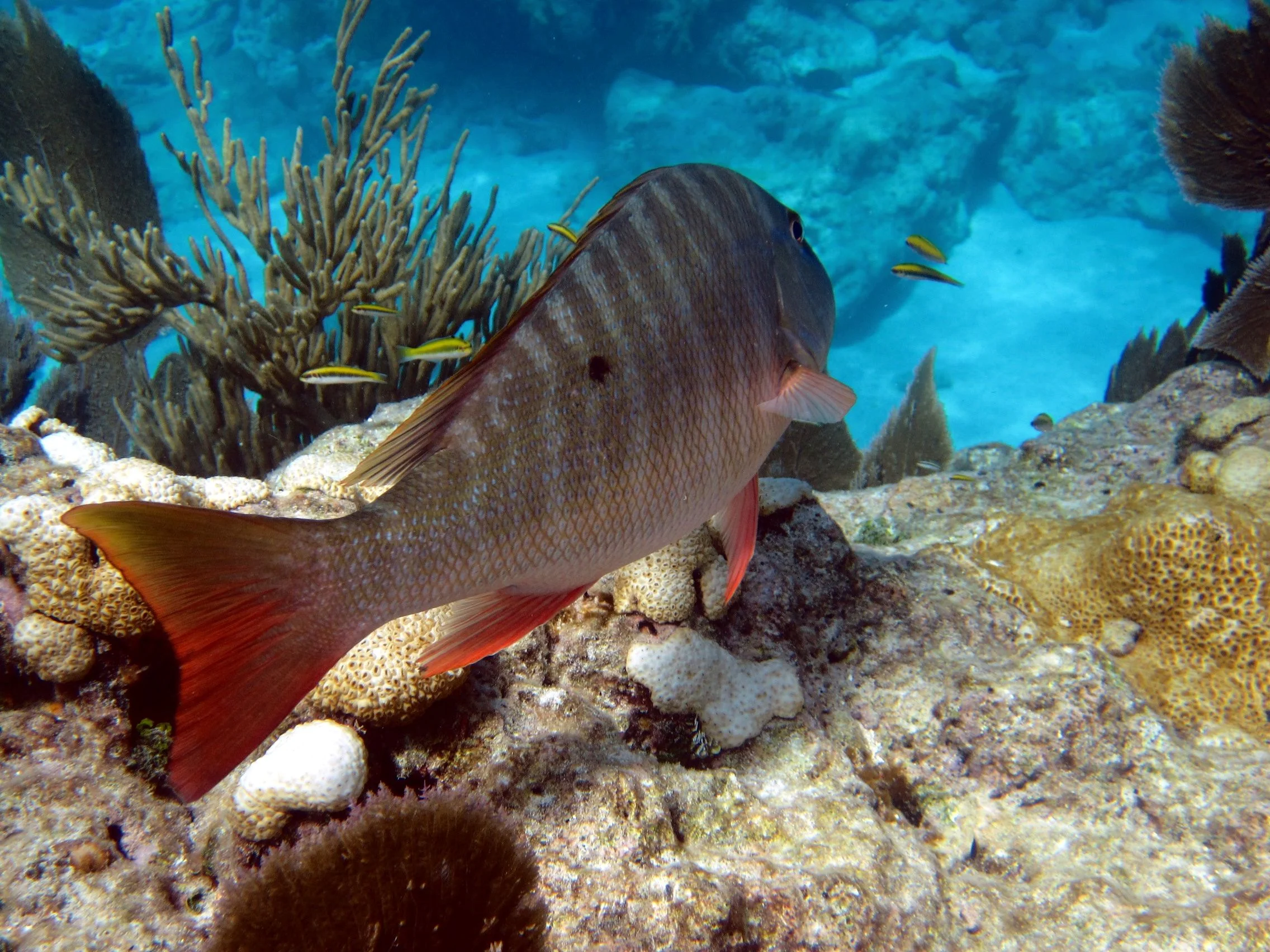
Introduction to the Mutton Snapper
The mutton snapper, also known as the king snapper or virgin snapper, is a favorite among fishermen. It lives in the western Atlantic Ocean. Classified as Lutjanus analis, it’s found from Massachusetts to Brazil. But it’s most common in Florida, the Bahamas, and the Caribbean Sea.
Scientific Classification and Naming
The mutton snapper is part of the Lutjanus genus. This group includes snappers from around the world’s warm and subtropical seas. The name “analis” comes from its pointed anal fin. This unique feature helps identify the mutton snapper.
Geographic Distribution and Habitat
Mutton snappers live in different marine spots. They’re found in offshore reefs, rock rubble, mangrove creeks, canals, and shallow bays. Young ones hide in turtle grass. They like waters from 60 to 300 feet deep, with the biggest ones in deeper waters in cooler months.
The best time to catch big mutton snappers is in spring and summer. During these months, they gather in large numbers. This makes them a top choice for anglers.
Physical Characteristics and Appearance
Mutton snappers have a deep body and a tail that looks almost like a crescent moon. They have a dorsal fin that splits into two parts and a sharp anal fin. Their pectoral fins are long, reaching just past the anal fin’s start.
Their colors are bright and beautiful. Their backs and upper sides are olive green. The lower sides and belly are a bit red. They also have blue stripes on their cheeks below the eyes. A small black spot is found on their upper back.
Size and Growth
Mutton snappers can grow quite large. They usually reach 20 inches in length, but can go up to 34.8 inches. They can weigh between 10 to 15 pounds. They can live up to 40 years.
Coloration and Distinguishing Features
The colors and markings of mutton snappers make them easy to spot. Their backs are olive green, and their sides and belly are red. The blue stripes on their cheeks are striking. A small black spot on their upper back also helps identify them.
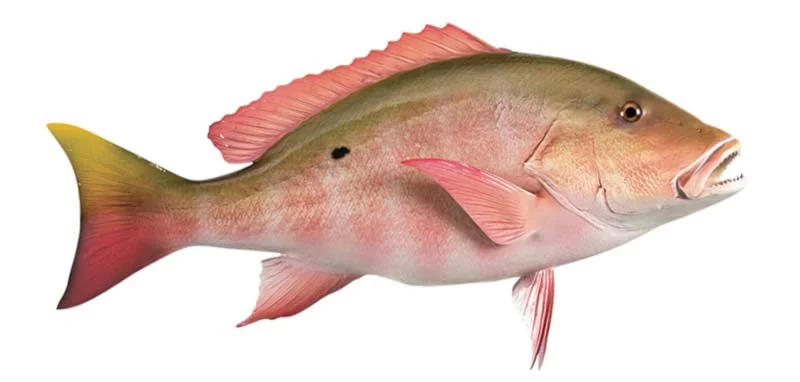
Mutton Snapper Behavior and Life Cycle
The mutton snapper is a fascinating fish with unique behaviors and a life cycle. They have interesting feeding habits and reproductive strategies. These insights make them intriguing to study.
Feeding Habits and Diet
Mutton snappers change their diet as they grow. Larvae eat plankton near the surface. Juveniles eat larger plankton and small invertebrates. Adults eat shrimp, crabs, snails, and small fish like mullet and grunts.
They are opportunistic predators, always looking for food. Their color changes based on what they eat. They turn darker with bars when eating from the bottom.
Reproduction and Spawning
Mutton snappers gather in large groups to spawn, especially in the northeastern Caribbean. They spawn in the summer, from May to August. They always come back to the same place to spawn.
They spawn by releasing eggs and sperm into the water. A female can lay up to 1,400,000 eggs. This shows how well they can reproduce.
Knowing about mutton snapper behavior and life cycle is key for conservation. By understanding them, we can protect these game fish for future generations.
Mutton Snapper as a Game Fish
The mutton snapper is a favorite among anglers. It’s known for its strong fight and tasty, firm flesh. Knowing the best ways to fish for mutton snapper can help you catch more.
Fishing Techniques and Baits
Anglers use different methods to catch mutton snappers. A knocker rig or jig works well, as it mimics natural movement. Chumming the water also attracts fish to the surface.
Once hooked, mutton snappers fight hard. They try to run along the ocean floor or hide in nearby structures. It’s important to handle them carefully to land them.
For bait, mutton snappers like pinfish, pilchards, and more. Anglers use a 6/0 circle hook on a mono leader. In strong currents, heavier sinkers help keep the bait down.
Culinary Value and Preparation
Mutton snappers are also prized for their taste. Their white, flaky flesh is perfect for grilling or other cooking methods. A simple seasoning of salt, pepper, and lemon brings out their natural flavors.
Whether baked, broiled, or pan-seared, mutton snappers are a seafood lover’s dream. They offer a delicious experience for anyone who enjoys cooking fish.
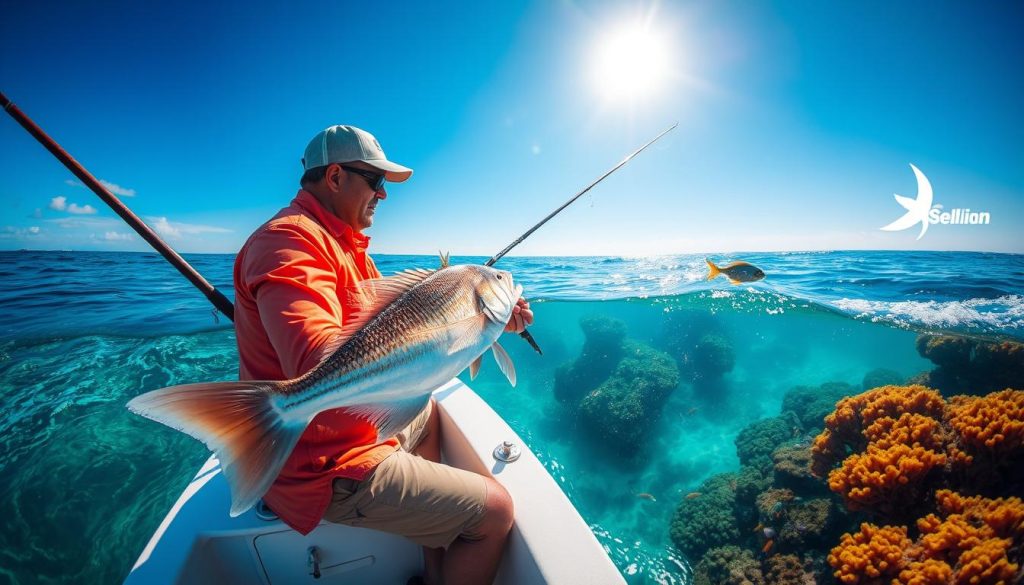
Conclusion
Mutton snappers are amazing game fish, known for their size, color, and tasty meat. They are very popular among anglers. But, this popularity has led to fewer mutton snappers in some places.
To protect them, fishery managers have set new rules. These include bigger minimum sizes and fewer fish you can catch each day.
If you want to catch these fish, a fishing charter in the Florida Keys is a great choice. It offers a memorable fishing trip. By following mutton snapper fishing rules and helping with mutton snapper conservation, you help keep these fish safe for the future.
Exploring and protecting the mutton snapper is important. It shows how vital it is to care for our oceans. Together, we can make sure these fish are around for a long time.
FAQ
What is the scientific classification and naming of the mutton snapper? The mutton snapper is known scientifically as Lutjanus analis. The name “analis” comes from its pointed anal fin. It belongs to the Lutjanidae family, which includes other snappers like the Red Snapper and Yellowtail Snapper.
Where can mutton snappers be found? Mutton snappers live in the western Atlantic Ocean. They are found from Massachusetts to Brazil. But they are most common in Florida, the Bahamas, and the Caribbean Sea.
They like different places to live, like offshore reefs and mangrove creeks. They also like shallow bays.
What are the physical characteristics and appearance of the mutton snapper? Mutton snappers have a deep body and a long, curved tail. They have a dorsal fin and a sharp anal fin. Their pectoral fins are long, reaching past the anal fin.
They are very colorful. Their backs and sides are olive green, with a red tint on their lower sides. They have blue stripes on their cheeks and a small black spot on their back.
How large can mutton snappers grow? Mutton snappers can grow up to 34.8 inches long. They can weigh up to 15 pounds. They can live up to 40 years.
What are the feeding habits and diet of mutton snappers? Baby mutton snappers eat plankton near the surface. As they grow, they eat more invertebrates. Adults eat shrimp, crabs, snails, and small fish. They are always looking for food, eating all day.
How do mutton snappers reproduce and spawn? Mutton snappers gather in large groups to spawn. This happens in the summer in the northeastern Caribbean. They come back to the same place every year.
Why are mutton snappers prized by anglers? Anglers love mutton snappers for their fight and tasty meat. They are hard to catch, but it’s worth it.
What are some effective fishing methods for catching mutton snappers? To catch mutton snappers, use a knocker rig or jig. Chumming also works well. Once caught, they try to run away, so you need to be careful.
How are mutton snappers prepared and consumed? Mutton snappers are great to eat. Their white meat is perfect for grilling or other dishes. They taste good with just salt, pepper, and lemon.
Source Links
- All About Mutton Snapper – Florida Keys Mutton Snapper Facts – https://mainattraction.org/florida-keys-mutton-snapper-facts/
- Learn About the Mutton Snapper – Fishing – https://guidesly.com/fishing/fish-species/mutton-snapper
- George Poveromo’s World of Saltwater Fishing 2023 – https://georgepoveromo.com/how_to_catch_mutton_snapper.html
- Mutton Snapper Fishing – Tips, Techniques, and Strategies – https://inthespread.com/blog/mutton-snapper-fishing-tips-techniques-and-strategies-336
- How to Catch Mutton Snapper – https://www.howtocatchanyfish.com/mutton-snapper.html
- Mutton Snapper – Fishing & Habitat – Travelfish – https://travelfish.net/fish/muttonsnapper/


